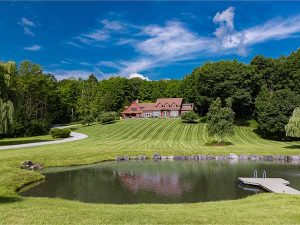The demand on the housing market and limited inventory, while easing a bit as we enter the fall and winter months, has continued to impact home prices. We are often asked what considerations go into the value of a home. Pricing a home is a science – as well as an art. Many considerations determine a home’s value and depending on the town and price point, some factors carry a greater weight.
To keep it simple, here are 10 key considerations that go into the value of a home.
 1. Location: The home’s location is one of the most significant factors affecting its value. Location amenities such as a neighborhood setting, proximity to jobs, schools, parks, shopping, and transportation can all be desirable to a prospective buyer, playing a part in the home valuation equation. In Vermont, proximity to natural amenities such as Lake Champlain, mountains, and ski areas can also impact a property’s value.
1. Location: The home’s location is one of the most significant factors affecting its value. Location amenities such as a neighborhood setting, proximity to jobs, schools, parks, shopping, and transportation can all be desirable to a prospective buyer, playing a part in the home valuation equation. In Vermont, proximity to natural amenities such as Lake Champlain, mountains, and ski areas can also impact a property’s value.
2. Size & Features: The size of the home, the number of bedrooms and bathrooms, and the overall layout and features (such as a garage, fireplace, or updated kitchen) all play a role in determining its value.
3. Condition & Upgrades: The property’s overall condition is crucial. Homes that are in good repair and well-maintained tend to have higher values. Upgrades to kitchens and baths or energy-efficient upgrades can also impact a home’s value. This includes both the interior and exterior of the property.
4. Comparable Sales: Recent sales of similar properties in the area help determine a home’s value. These are known as “comps.” Comparable sales help establish a baseline for the property’s worth.
5. Market Conditions: The state of the real estate market at the time of sale can impact a home’s value. In a seller’s market, where demand is high and supply is low, (as it currently is) prices tend to rise. In a buyer’s market, where there are more homes for sale than buyers, prices may stagnate or sometimes decline.
6. Property Age: The age of the home can also influence its value. Older homes with historical significance may have a higher value, while newer homes may be more attractive to buyers seeking modern amenities and lower maintenance.
 7. Land and Lot Size: The size and features of the land or lot can impact its value. Larger lots or those with sub-division possibilities and unique features like waterfront access or mountain or water views may command higher prices.
7. Land and Lot Size: The size and features of the land or lot can impact its value. Larger lots or those with sub-division possibilities and unique features like waterfront access or mountain or water views may command higher prices.
8. Zoning and Regulations: Local zoning laws and regulations can affect a property’s value by dictating what can be built on the land, how it can be used, and any restrictions on renovations or additions. Homes within an association that has fees and/or bylaws and covenants will also influence value. An association with amenities like pools or playgrounds may increase value for some purchasers.
9. Economic Factors: Broader economic factors, such as interest rates, employment rates, and the overall health of the local and national economy, can also influence property values.
10. Seasonal Factors: In Vermont, the time of year can be a factor. For example, properties on the lake or near ski areas may have minor seasonal fluctuations in value based on winter and summer demand. This factor, however, is less influential than location and all the other items noted above.
And, for an extra bonus, another factor is your MOTIVATION & GOALS. Whether you are buying or selling, your goals cannot be overlooked. I’m here to provide you with expert advice every step of the way to help you achieve your goals.


 Facebook
Facebook
 X
X
 Pinterest
Pinterest
 Copy Link
Copy Link


